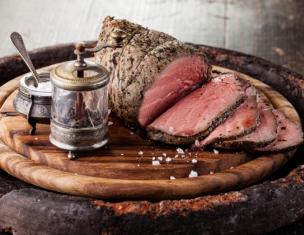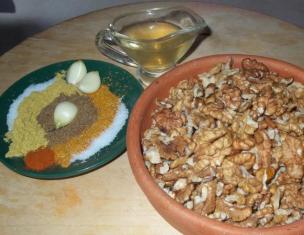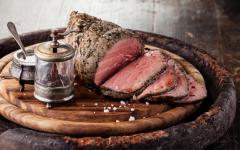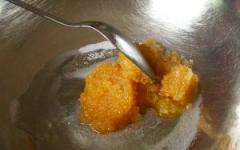“Bazhe” sauce is a classic seasoning of Georgian cuisine, which is used with many main dishes. For example, it tastes great with poultry, fish and even vegetables. The most popular version of this sauce is with the addition of peeled walnut kernels.
How to make the taste of a dish unique?
If you want your guests and relatives to remember your dish for a long time, use Bazhe sauce. This is a classic oriental delicacy. It is versatile and very easy to prepare. The process will not take much of your time and effort. Any Georgian housewife can easily prepare Bazhe sauce. But almost every woman has her own secrets that make this liquid seasoning served with the main dish unique and original. We will look at the classic recipe.
Main Ingredients
So, in order to prepare the Bazhe sauce, we do not need many products. Most of them are always at hand for every housewife. First of all, these are walnuts. To make the sauce rich, take one and a half glasses, no less. In addition, we will need garlic; almost no Georgian dish, much less a seasoning, can do without it. You will need to take either three large cloves or 6-8 small ones. It is also necessary to boil water in advance - 400 grams (two glasses). We also cannot do without half a lemon. If desired, you can replace it with 3-4 tablespoons of white wine vinegar. And finally, we will need salt to taste.

Cooking process
Let's start with nuts. To make a delicious Bazhe sauce, the recipe suggests grinding them thoroughly. Don’t be lazy - choose the best, most selective kernels. After all, the final taste of the seasoning largely depends on their quality. You can grind nuts in any way. In the old days this was done in a mortar, in Soviet times - in a meat grinder. In the latter case, the nuts need to be ground twice. Today there are special mills that make this task much easier.

Afterwards, put the already ground nuts into a blender. His task is to mix all the ingredients thoroughly. Add salt, pre-crushed garlic, and add boiled water. Make sure that the Bazhe sauce with walnuts does not turn out too liquid. It’s best not to add all the water at once, but add it gradually.

Now whisk everything thoroughly. According to your desire and taste, you can add various Georgian spices and seasonings to the sauce. Saffron, pepper, hops will do. In a word, feel free to put everything you love. Pour the resulting mixture into a separate bowl and squeeze half a lemon into it or add vinegar, as you prefer. Afterwards we filter all the resulting juice. Ultimately, your sauce should be no thicker than kefir. Otherwise, it can be diluted with the remaining boiled water. Now mix everything with a regular tablespoon and serve.

By the way, Georgians themselves do not recommend using the sauce with meat. But there are gourmets who have a different point of view. In its classic form, “Bazhe” is served with chicken, often boiled or fried. In restaurants they put it directly into the sauce. The delicacy with fish, zucchini, cauliflower and eggplant is also well savored. Many people like to dip bread or flatbreads in it.
Bon appetit, successful culinary experiments in the kitchen!
Georgian nut sauce bazhe is ideal as a side dish sauce for chicken and fish. Just like satsivi, bazhe is prepared very often in Georgia; it is a universal nut sauce that absolutely every housewife can prepare. Preparing bazhe is very simple, the most important thing is to choose light and non-bitter nuts for the bazhe. Try it, this is a very tasty dish! A real bazhe should be light in color and have a slightly thick consistency.
Bazhe - nut sauce
Ingredients
– walnuts – 250 g,
- garlic - 2 cloves,
- chicken broth or boiled water,
- Georgian spices: suneli hops, cilantro and yellow flower (Imereti saffron (marigolds of the Asteraceae family)) - 1 teaspoon each,
- ground red pepper,
- wine vinegar - to taste, approximately 1 tbsp,
- salt - to taste.
See another recipe, Abkhazian: .
Preparation
Walnuts should be minced 2-3 times. Instead of a meat grinder, you can use a blender. To the rolled nut mass add chopped garlic, spices (suneli hops, cilantro and yellow flower), salt and ground red pepper.
The mass should be mixed well, but not with a spoon, but with your hands. Many housewives in Georgia knead the ground nuts and squeeze out the nut oil, which is collected in a separate bowl, then when serving, pour this oil over the bazhe sauce (the dry nut mass, when kneaded with your hands for 5 minutes, becomes greasy and moist and releases nut oil). You don't have to do this. By the way, the nut butter obtained in this way is very tasty and ideal for dressing salads.

Dilute the nut mass with spices with chilled chicken broth or boiled water to the desired consistency. Add wine vinegar to taste.
Serve with fish, fried or boiled chicken.
By the way, if you put boiled chicken in the Bazhe sauce, you will get one of the varieties of satsivi, because satsivi is prepared in different ways.
Personally, I like to cook it with the addition of water, without chicken broth - I like it better) And I use only wine vinegar in the recipe; table vinegar, and especially apple vinegar, is not suitable.
If you go to a Georgian feast, there will definitely be Bazhe sauce in bowls covered with amber-yellow nut butter - one of the most popular sauces in Georgia and, believe me, very, very tasty! It can be used on holidays and for those who are fasting or vegetarian, due to slight variations in preparation.
You can season chicken, fish, or, for example, cauliflower or broccoli with the sauce. It is also customary to eat it with gomi - this is a type of corn porridge - mamalyga, you can with - corn flatbreads or simply by dipping a piece of Georgian bread - shoti or lavash into it (not to be confused with Armenian thin lavash). Spices: coriander (cilantro seeds), fenugreek (utskho suneli), Imeretian saffron (common yellow marigolds). red pepper should be crushed, like powder. If you couldn’t find utskho suneli, take suneli hops, but twice as much, since it already contains coriander.
Georgian cuisine: walnut bazhe sauce
step by step recipe with photos






Ingredients for Bazhe sauce:
- 400 g walnuts,
- 3 cloves of garlic,
- salt,
- 1 tsp dried blue fenugreek (utskho suneli),
- 1 tsp dried coriander,
- 1 tsp dried red pepper (to taste)
- 1 tsp Imeretian saffron
How to prepare Georgian sauce Bazhe
1. Grind the walnuts (you can use a blender or meat grinder) and crush the garlic separately.
2. The next step is the most difficult, you need to grate the nuts passed through the meat grinder, pressing on them with the back of a spoon to extract the walnut oil. The oil is later used in the bazhe sauce: the finished dish is added. However, you can skip this step.
3. Add chopped garlic, spices and salt to a bowl with walnuts.
4. Pour 50 ml of boiled, cooled water into the mixture and mix and mash with a fork.
5. Continue adding water, constantly stirring and grinding, until the sauce looks approximately like the photo. like thin sour cream.
Bazhe can be cooked in chicken broth, or add a tablespoon of wine or apple cider vinegar or lemon juice at the very end.
Bazhe can be served with, or prepared for the New Year's table.
Calories: Not specified
Cooking time: Not indicated
Oh, this colorful Georgian cuisine - meat, delicious sauces, spices, herbs, just the thought excites all the taste buds. Today I want to invite you to prepare a sauce in Georgian under such an incredibly beautiful name “Bazhe”. According to the classic recipe, this sauce is prepared with walnuts, and you can’t do without garlic, herbs, ground coriander, suneli hops, and paprika. The taste is incredibly rich, the sauce is ideal for meat, poultry, turkey, and vegetables. Just imagine how this sauce will combine with - perfect! You can fill Bazhe not only with water, as in our case, you can use chicken broth. Perhaps you can get ground fenugreek seeds and saffron, then by all means add them to the sauce, the taste will take on a new rich shade. So, let's plunge a little into this beautiful and vibrant Georgian cuisine, at least prepare the sauce, and then add meat to it (for example), lavash, vegetables.
- walnuts (shelled) – 100 g,
- coriander – 0.25 tsp,
- paprika – 1 tsp,
- hops-suneli – 1 tsp,
- garlic – 1-2 large cloves,
- water – 120-150 ml,
- greens (cilantro, parsley) - to taste,
- salt, pepper - to taste.
Recipe with photos step by step:

Prepare the blender bowl. Peel the walnuts and measure out one hundred grams. Place the nuts in a blender bowl. 
Grind the nuts in a bowl at high speed until fine crumbs. 
Add spices to the nut crumbs - ground sweet paprika, ground coriander, suneli hops. The amount of spices can be increased later. 
Add a little salt and garlic to the blender bowl. 
Wash and dry your favorite herbs; cilantro and parsley will fit perfectly here. 
Add clean filtered water in portions and grind the sauce to the desired consistency. Test for spices and add more if necessary. 
Then serve the sauce to the table. 
Bon appetit!
Be sure to try another delicious one
The idea was this: to tell about the traditional recipe for satsivi. But the task of finding a classic, authentic recipe turned out to be more difficult than at first glance. One thing can be said more or less accurately: both satsivi and bazhe are not the names of the dish, but the name of the nut sauce (so you understand: satsivi has more ingredients and the preparation is more complicated, bazhe is the same thing, but simpler). Moreover, this sauce is used with poultry, meat, and even fish. But sources agree that the classic version is satsivi with poultry: turkey (a holiday dish) or chicken (a more everyday option).
Then researchers and amateur cooks go into the wilds of history, trying to find out what region of the country this dish comes from and what the original recipe is. After wandering around the Internet and talking with housewives, we came to the conclusion that this dish is prepared like this: in the case of housewives, how the grandmother (mother/mother-in-law, etc.) cooked it, in the case of researchers, who likes which theory best.
To put it very briefly and discard the rare options with fish and meat, the essence of the dish is this: take the bird, cook it, pour it with nut sauce, infuse it, serve it and eat it cold. All the recipes agree on this. And then there are a million options: some boil the bird, some fry it, some bake it in the oven, some even cook it until half cooked and then finish it over charcoal. It’s the same story with the sauce: the set of spices is different, in some versions the sauce is mixed with broth, in others with water. In general, you can go crazy.
We did this: we took the simplest and fastest recipe and prepared Bazhe - so to speak, satsivi-light. Looking ahead, it turned out delicious :)
We share the recipe we used to prepare it. In general, in this version you can cook chicken in any way you like: fry, bake or boil.
So, what do you need for a “quick” satsivi (2-3 servings). If the chicken is larger, increase the proportions - especially nuts - you should never skimp on them.
- Fresh chicken, not frozen – 1-1.5 kg. (ideally young, not big, not a huge broiler)
- Walnut. At least 300-400 gr.
- Garlic 8-15 cloves (less old, more young, but generally to taste)
- Ground dry cilantro 0.5 tsp. (without top) (we didn’t have one, but it’s better to get one)
- Utskho-suneli 0.5 tsp. (without top)
- Ground red hot pepper - a pinch
- Ground white pepper - a pinch
- Ground cloves - a pinch
- Cinnamon - a pinch
- Yellow flower (saffron) - a pinch (if in powder, then more)
We salted and peppered the chicken (you rub the carcass with your hands), cut it along the breast, and fried it whole in a frying pan under pressure - in the manner of “tabaka” chicken. It is important not to overcook - when punctured, a little white juice should flow out (if red juice flows out, it’s not ready). Fry it on both sides and leave it to cool (covered so it doesn't dry out).
If you bake, you need to water it with juice, otherwise it will dry out. If you cook, add a little salt, you can add fresh herbs to the pan in one bunch: cilantro, parsley, a sprig of basil. Do not cut the greens, you will need to pull them all out later.
Prepare the sauce. Carefully sort the nuts: discard all internuclear plates, get rid of any dried and transparent nuts when scrapped. If you don’t overdo it, the sauce will be bitter.
Grind the nuts into dust. If you use a meat grinder, then skip it 2-3 times; if you use an electric grinder, then it’s easier – just press the button hard and you’re done :)
Peel the garlic, grind it in the same way as with nuts - into dust. You can use a garlic press.
Throw the garlic into the nuts, add spices: utskho-suneli, red and white pepper, cinnamon, dry cilantro (if found), cloves, saffron. Salt it a little. We didn’t have cilantro, we sprinkled in a little cardamom – on our own, not as part of the recipe. He didn’t ruin the matter :)
The proportion of spices indicated above is very light. If you like a stronger, spicy taste, add more. The basis of the taste is here: utskho-suneli, cilantro. You can increase the portion of cinnamon + pepper - it turns out interesting. Taste the mixture and adjust the taste.
Next you need to work with your hands for about 15 minutes. Knead the mixture thoroughly, press it, knead it, knead it - eventually the nut oil should begin to separate, and the mixture should become homogeneous (it is still dry, so you won’t get a creamy mixture, but after kneading, there will be lumps break everything).

Slowly begin to add water - 2-3 tablespoons to start. Stir again with your hands and press in the water. The mixture should become homogeneous, without lumps or dry spots, and begin to turn white - this is the nut oil reacting with water. If it doesn’t turn white, it’s bad - knead it harder so that the oil is released.
In the same way, little by little, we continue to pour in water - a maximum of a third of a glass at a time. Stir with your hands all the time - the water should not hang out separately, the mass becomes thinner, but remains homogeneous.
In total we poured in about 0.5 liters of water. If you have more nuts and spices, add more. The consistency should be no thinner than pancake batter. Maybe a little thicker. The sauce should pour out of the spoon, but not be liquid. Taste and adjust salt, pepper and garlic. Add some of the spices if you really want to. At the end we added more garlic and fresh parsley – chopped.
Accordingly, if you boiled the chicken rather than fried it, you can use broth instead of water to dilute the sauce. Just let it cool first.

The sauce turned white and became the desired consistency. The chicken is ready. Cut it into portions, place in a mold, pour in the sauce (it should completely cover all the pieces). Place in a cool place (or refrigerator). Ideally, the dish should sit for several hours - then the meat will be saturated with the sauce and will be more interesting.
The dish is not heated when serving. But it shouldn’t be icy either - take it out of the refrigerator before eating - let it be at room temperature. Garnish with herbs or pomegranate seeds.
Traditionally, satsivi and bazhe are served with lavash or gomi (corn porridge). This time we made do with delicious Georgian tomatoes. It's delicious, try it!
The wine is white dry. The best thing is Georgian, ideally young homemade.









